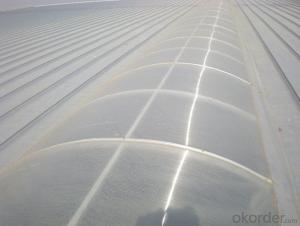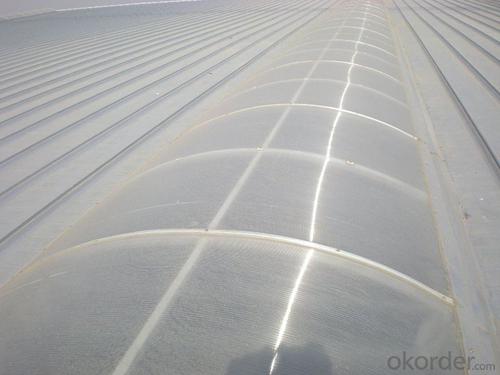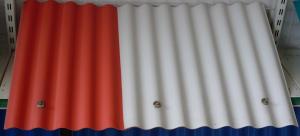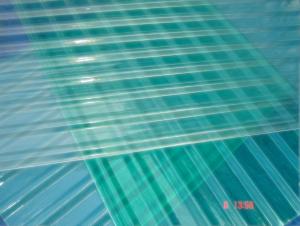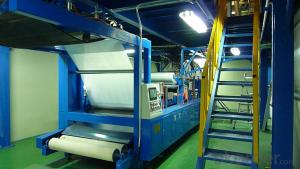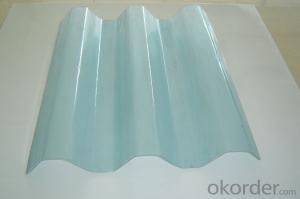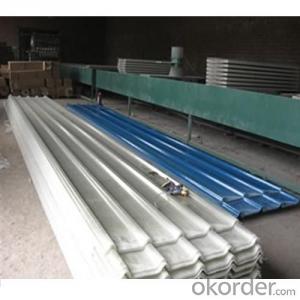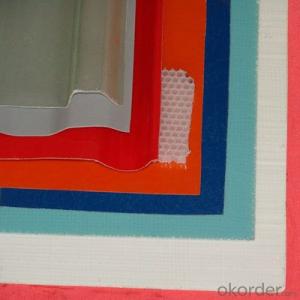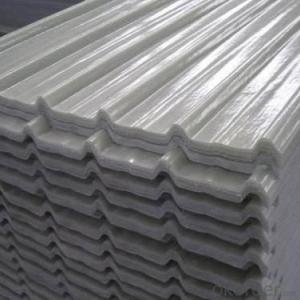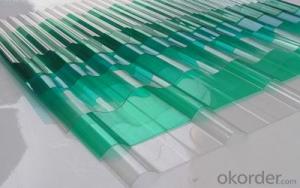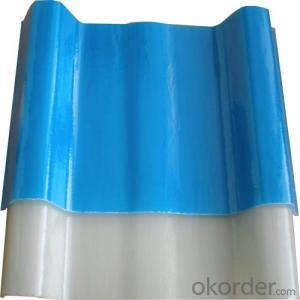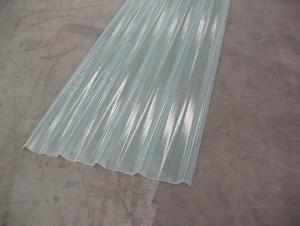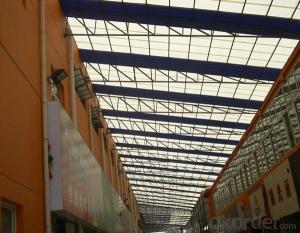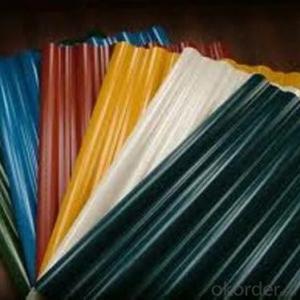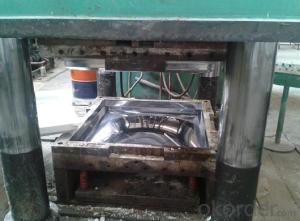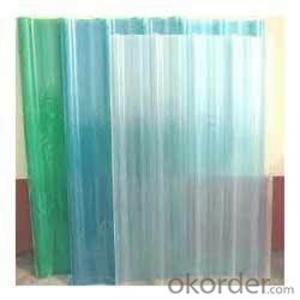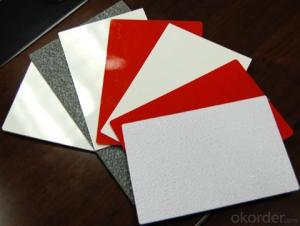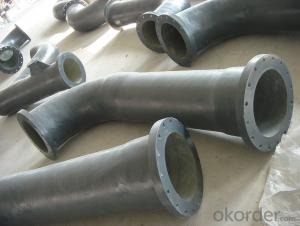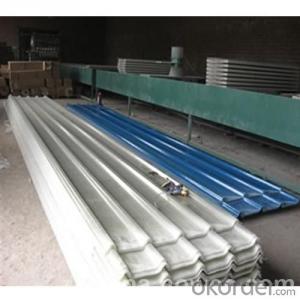High strength Transparent corrugated FRP/GRP panel FLAT
- Loading Port:
- China main port
- Payment Terms:
- TT or LC
- Min Order Qty:
- 100 kg
- Supply Capability:
- 100000 kg/month
OKorder Service Pledge
OKorder Financial Service
You Might Also Like
1,fibreglass sheet,FRP panels,fibreglass panel,corrugated sheet
2,transparent ,lightblue ,red and other color
3,Features:
1)High light transparency
2)Light weight and high strength
3)Corrosion and impact resistance
4)Anti-UV, anti-static, insulation
5)Accurate cross-section size
6)The length of the random cutting and more
7)Widely used in industrial plants, large-scale treasury markets, greenhouse, aquaculture and tourism
8)Used as roof, wall panel and more
9)Supports good lighting effect
4,Index :
Unit Weight: 1800g/m² 2400g/m² 3050g/m²
Nominal Thickness:0.8mm,1.0mm, 1.2mm 1.5mm 2.0mm, 2.5mm
Heat Resistance Limit: -60 to +130
Light Transmittance: 75%±2% ( light green) 53%±2% (cream white)
Anti- ultraviolet Rate: 99.9%
Tensile Strength: 100Mpa
Flexural Strength: 180Mpa
Cracking Elongation Rate: 1.9%
Pasture Hardness: ≥50
Thermal Expansion Coefficient: 2.2×10¯125px/cm/
Thermal Conductivity: 0.18w/m° k
Warranty:15 years
Item | Data | Reference | Item | Data | Reference |
Tensile modulus(Gpa) | 6.92 | GB | catalyst cold temperature | -52 | GB |
tensile strength(Gpa) | 103 | GB | heat distortion temperature | 172 | GB |
flexural modulus(Gpa) | 6.00 | GB | glass fiber content | above30% | GB |
flexural strength(Gpa) | 171 | GB | water absorption% | 0.18 | GB |
shear strength(Gpa) | 89.9 | GB | specific gravity | 1.48g/cm² | GB |
Barcol hardness | 47 | GB | Coefficient of thermal expansion | 1.5-2.2*10-5 | GB |
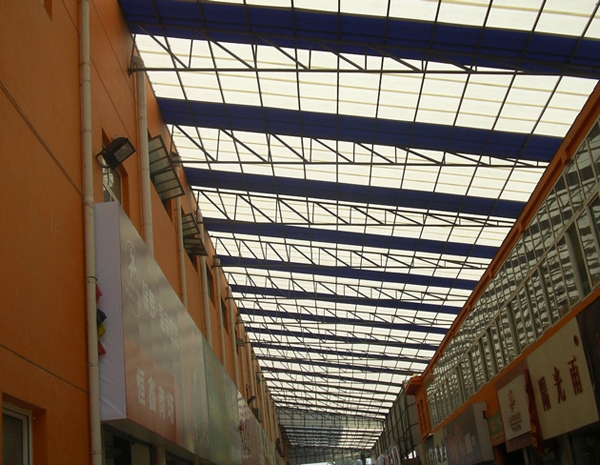
- Q: Can FRP roofing panels be installed on curved surfaces?
- Yes, FRP roofing panels can be installed on curved surfaces. These panels are flexible and can be easily bent or molded to fit the shape of a curved surface, making them a suitable choice for such installations.
- Q: Are FRP roofing panels suitable for parking structures?
- Yes, FRP (Fiberglass Reinforced Plastic) roofing panels are suitable for parking structures. FRP roofing panels are known for their durability, lightweight nature, and resistance to corrosion, making them an excellent choice for parking structures. These panels are designed to withstand harsh weather conditions, including heavy rain, snow, and hail, while providing a long-lasting and low-maintenance roofing solution. Moreover, FRP roofing panels offer excellent UV resistance, preventing color fading or degradation over time. This is particularly important in parking structures, where vehicles are often exposed to direct sunlight for extended periods. The UV resistance of FRP panels ensures that the roofing remains aesthetically pleasing and does not require frequent painting or touch-ups. Additionally, FRP roofing panels can be installed quickly and easily due to their lightweight nature. This reduces the construction time and cost associated with parking structure projects. Furthermore, the lightweight feature of FRP panels puts less stress on the building's structure, making them an ideal choice for retrofitting existing parking structures. Another advantage of FRP roofing panels is their ability to be customized to suit specific design requirements. These panels can be manufactured in various profiles, colors, and thicknesses, allowing architects and builders to achieve the desired aesthetic while maintaining functionality and performance. In conclusion, FRP roofing panels are a suitable choice for parking structures due to their durability, lightweight nature, resistance to corrosion, UV resistance, ease of installation, and customization options. These panels provide a long-lasting and low-maintenance roofing solution that can withstand harsh weather conditions, making them an ideal choice for parking structures of all sizes.
- Q: Do FRP roofing panels have good sound insulation properties?
- Yes, FRP (Fiberglass Reinforced Plastic) roofing panels have good sound insulation properties. The multiple layers of fiberglass and plastic in FRP panels help to absorb and dampen sound waves, reducing noise transmission. This makes FRP roofing panels an effective choice for sound insulation in various applications, such as industrial buildings, warehouses, and residential structures.
- Q: What is the installation process for FRP roofing panels?
- The installation process for FRP roofing panels typically involves the following steps: 1. Prepare the surface: Ensure that the roof surface is clean, dry, and free from any debris or loose materials. 2. Measure and cut the panels: Measure the dimensions of the roof and cut the FRP panels to fit accordingly. Use a saw or shears specifically designed for cutting fiberglass. 3. Apply adhesive: Apply a suitable adhesive or sealant to the roof surface in a consistent manner. This will help create a secure bond between the roof and the FRP panels. 4. Position the panels: Carefully position the panels onto the adhesive, starting from one end and working your way to the other. Ensure that they are aligned properly and firmly pressed down. 5. Secure the panels: Use screws or nails to secure the FRP panels in place. These should be applied at the recommended intervals and in accordance with the manufacturer's guidelines. 6. Seal the joints: Apply a sealant or caulk to the joints between the panels to prevent any water or moisture from seeping through. 7. Allow for curing time: Give the adhesive and sealant enough time to cure and dry as per the manufacturer's instructions. This will ensure a strong and durable installation. 8. Inspect and maintain: Once the installation is complete, inspect the roof periodically to identify any potential issues or damages. Regular maintenance, such as cleaning and resealing, can help extend the lifespan of the FRP roofing panels. It is important to note that the specific installation process may vary depending on the manufacturer's recommendations and the specific design of the FRP roofing panels. Therefore, it is always advisable to refer to the manufacturer's installation guidelines for detailed instructions.
- Q: Can FRP roofing panels be used in mobile homes?
- Yes, FRP (Fiberglass Reinforced Plastic) roofing panels can be used in mobile homes. FRP panels are lightweight, durable, and have excellent resistance to weathering and UV radiation, making them suitable for various applications, including roofing. They provide a cost-effective alternative to traditional roofing materials and offer good insulation properties. Additionally, FRP panels are easy to install and require minimal maintenance, making them a suitable choice for mobile homes where mobility and convenience are essential. However, it is important to ensure that the mobile home's structure is compatible with the installation of FRP roofing panels and that all necessary precautions are taken during installation to ensure proper sealing and waterproofing.
- Q: Can FRP roofing panels be used for walkways?
- No, FRP roofing panels are not suitable for walkways.
- Q: Are FRP roofing panels suitable for ice and snow regions?
- FRP (Fiberglass Reinforced Plastic) roofing panels have certain qualities that make them suitable for ice and snow regions, but there are also some considerations to keep in mind. One of the main advantages of FRP roofing panels in cold climates is their durability. They are highly resistant to impact, cracking, and splitting, which is crucial when dealing with heavy snowfall and ice buildup. FRP panels do not absorb moisture, so they do not become brittle or warp when exposed to freezing temperatures. Additionally, they have a high resistance to corrosion and do not rot or rust, making them ideal for regions with harsh winter weather. Another factor to consider is the thermal conductivity of FRP roofing panels. They have a low thermal conductivity, meaning they do not transfer heat easily. This can be beneficial in ice and snow regions, as it helps to prevent the formation of ice dams on the roof. Ice dams occur when heat from the interior of the building escapes through the roof, causing the snow to melt and refreeze at the roof edges. FRP panels can help to maintain a more consistent temperature on the roof surface, minimizing the risk of ice dams. However, it is important to note that FRP roofing panels are not entirely immune to ice and snow-related issues. Like any other roofing material, they can still accumulate snow and ice, which may need to be cleared periodically to prevent excessive weight on the roof. Additionally, proper installation and insulation are crucial to ensure the panels perform optimally in cold climates. Adequate ventilation and insulation in the attic space can help to prevent the formation of ice dams and reduce heat loss. Overall, FRP roofing panels can be a suitable choice for ice and snow regions due to their durability, resistance to moisture and corrosion, as well as their low thermal conductivity. However, it is essential to consult with a professional and ensure proper installation and maintenance to maximize their effectiveness in these specific climatic conditions.
- Q: Can FRP roofing panels be installed over an existing roof?
- Installing FRP roofing panels over an existing roof is indeed possible. However, several factors warrant consideration before proceeding with this installation approach. Initially, it is crucial to ascertain the soundness of the current roof's structure and its ability to withstand the weight of the FRP panels. Additionally, any pre-existing leaks or damages should be addressed and repaired before installing the new panels. Ensuring appropriate insulation and ventilation is also vital to prevent condensation and moisture buildup between the existing roof and the FRP panels. Lastly, it is advisable to consult a professional roofing contractor with expertise in FRP installations to guarantee optimal outcomes and adherence to local building codes and regulations.
- Q: Can FRP roofing panels be used in areas with frequent lightning strikes?
- FRP roofing panels can indeed be utilized in regions with prevalent lightning occurrences. These panels are renowned for their remarkable electrical insulation properties, rendering them an appropriate choice for such high-risk zones. The fiberglass material incorporated in FRP panels is non-conductive, implying that it does not conduct electricity. This characteristic guarantees that the panels do not attract or conduct lightning strikes, thus diminishing the likelihood of damage or fire hazards. Furthermore, FRP panels also possess resistance against corrosion, thereby augmenting their suitability for areas prone to frequent lightning strikes. Nevertheless, it is imperative to acknowledge that although FRP panels may offer a degree of protection against lightning, it is always advisable to seek advice from a professional or adhere to local building codes and regulations to ensure the proper installation and implementation of safety measures.
- Q: Are FRP roofing panels suitable for modular buildings or prefabricated structures?
- Yes, FRP (Fiberglass Reinforced Plastic) roofing panels are suitable for modular buildings or prefabricated structures. FRP roofing panels offer numerous advantages that make them an ideal choice for such structures. Firstly, FRP panels are lightweight, which makes them easy to transport and install on modular buildings or prefabricated structures. This lightweight characteristic reduces the overall weight of the structure, which can be beneficial for transportation and assembly purposes. Secondly, FRP roofing panels are highly durable and have a long lifespan. They are resistant to corrosion, weathering, and UV radiation, which ensures that they can withstand various environmental conditions and maintain their structural integrity over time. This durability is crucial for modular buildings or prefabricated structures, as they are often exposed to different weather conditions during transportation and installation. Moreover, FRP roofing panels offer excellent thermal insulation properties. They can effectively regulate the temperature inside the building, reducing the need for additional insulation materials and improving energy efficiency. This is especially important for modular buildings or prefabricated structures, as they may have limited insulation options due to their design and construction process. Additionally, FRP panels are available in a variety of colors and finishes, allowing for customization and aesthetic appeal. This makes them suitable for various architectural styles and design preferences, ensuring that the modular buildings or prefabricated structures can blend well with their surroundings. In conclusion, FRP roofing panels are indeed suitable for modular buildings or prefabricated structures. Their lightweight nature, durability, thermal insulation properties, and aesthetic options make them a practical and efficient roofing solution for these types of structures.
Send your message to us
High strength Transparent corrugated FRP/GRP panel FLAT
- Loading Port:
- China main port
- Payment Terms:
- TT or LC
- Min Order Qty:
- 100 kg
- Supply Capability:
- 100000 kg/month
OKorder Service Pledge
OKorder Financial Service
Similar products
Hot products
Hot Searches
Related keywords
